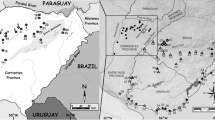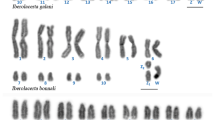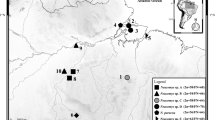Abstract
We examined the chromosomal localization of the telomeric sequence, (TTAGGG)n, in seven species of the lemurs and one greater galago, as an outgroup, using the primed in-situ labeling (PRINS) technique. As expected, the telomeric sequence was identified at both ends of all chromosomes of the eight prosimians. However, six species showed a signal at some pericentromeric regions involving constitutive heterochromatin as well. The pericentromeric region of chromosome 1 of Verreaux's sifaka (Propithecus verreauxi verreauxi) was labeled with a large and intense signal. The range of the signal considerably exceeded the area of DAPI positive heterochromatin. On the other hand, in the five lemurs, a large signal was detected also in the short arm of acrocentric chromosomes. Acquisition of the large block of the telomeric sequence into the acrocentric short arm might be interpretable in terms of the tandem growth of the heterochromatic short arm and the reciprocal translocation between heterochromatic short arms involving the telomeric sequence. Subsequently, it was postulated that meta- or submetacentric chromosomes possessing the telomeric sequence at the pericentromeric region could be formed by centric fusion between such acrocentric chromosomes.
Similar content being viewed by others
References
Apiou F, Rumpler Y, Warter S, Vezuli A, Dutrillaux B (1996) Demonstration of homoeologies between human and lemur chromosomes by chromosome painting. Cytogenet Cell Genet 72: 50–52.
Azzalin CM, Mucciolo E, Bertoni L, Giulotto E (1997) Fluorescence in situ hybridization with a synthetic (T2AG3)n polynucleotide detects several intrachromosomal telomere-like repeats on human chromosomes. Cytogenet Cell Genet 78: 112–115.
Bertoni L, Attolini C, Faravelli M, Simi S, Giulotto E (1996) Intrachromosomal telomere-like DNA sequences in Chinese hamster. Mamm Genome 7: 853–855.
Ferguson-Smith MA, Handmaker SD (1963) The association of satellited chromosomes with specific chromosomal regions in cultured human somatic cells. Ann Hum Genet 27: 143–155.
Garagna S, Broccoli D, Redi CA, Searle JB, Cooke HJ, Capanna E (1995) Robertsonian metacentrics of the house mouse lose telomeric sequences but retain some minor satellite DNA in the pericentromeric area. Chromosoma 103: 685–692.
Garagna S, Ronchetti E, Mascheretti S et al. (1997) Non-telomeric chromosome localization of (TTAGGG)n repeats in the genus Eulemur. Chromosome Res 5: 487–491.
Henderson AS, Warburton D, Atwood KC (1976) Chromosomal distribution of rDNA in Pan paniscus, Gorilla gorilla beringei, and Symphalangus syndactylus: comparison to related primates. Chromosoma 16: 147–155.
Hirai H, LoVerde PT (1995) FISH techniques for constructing physical maps on schistosome chromosomes. Parasitol Today 11: 310–314.
Hirai H, Hasegawa Y, Kawamoto Y, Tokita E (1998) Tandem duplication of nucleolus organizer region (NOR) in the Japanese macque, Macaca fuscata fuscata. Chromosome Res 6: 191–197.
Imai HT (1978) On the origin of telocentric chromosomes in mammals. J Theor Biol 71: 619–637.
Imai HT, Crozier RH (1980) Quantitative analysis of directionality in mammalian karyotype evolution. Am Nat 116: 537–569.
Imai HT, Maruyama T, Gojobori T, Inoue Y, Crozier RH (1986) Theoretical bases for karyotype evolution. 1. The minimuminteraction hypothesis. Am Nat 128: 900–920.
Imai HT, Wada MY, Hirai H, Matsuda Y, Tsuchiya K (1999) Cytological, genetic and evolutionary functions of chiasmata based on chiasma graph analysis. J Theor Biol 198: 239–257.
Jantsch M, Hamilton B, Mayr B, Schweizer D (1990) Meiotic chromosome behaviour reflects levels of sequence divergence in Sus scrofa domestica satellite DNA. Chromosoma 99: 330–335.
Kolnicki R (1999) Karyotypic fission theory applied kinetochore reproduction and lemur evolution. Symbiosis 26: 123–141.
Lee C, Sasi R, Lin CC (1993) Interstitial localization of telomeric DNA sequences in the Indian muntjac chromosomes: further evidence for tandem chromosome fusions in the karyotypic evolution of the Asian muntjacs. Cytogenet Cell Genet 63: 156–159.
Mayr-Wohlfart U, Adolph S, Klett C, Hameister H (1987) Metaphase association of mammalian chromosomes. Genome 29: 807–810.
Metcalfe CJ, Eldridge MDB, McQuade LR, Johnston PG (1997) Mapping the distribution of the telomeric sequence (T2AG3)n in rock-wallabies, Petrogale (Marsupialia: Macropodidae), by fluorescence in situ hybridization. I. The penicillata complex. Cytogenet Cell Genet 78: 74–80.
Metcalfe CJ, Eldridge MDB, Toder R, Johnston PG (1998) Mapping the distribution of the telomeric sequence (T2AG3)n in the Macropodoidea (Marsupialia), by fluorescence in situ hybridization. I. The swamp wallaby, Wallabia bicolor. Chromosome Res 6: 603–610.
Meyne J, Ratliff RL, Moyzis RK (1989) Conservation of the human telomere sequence (TTAGGG)n among vertebrates. Proc Natl Acad Sci USA 86: 7049–7053.
Meyne J, Baker RJ, Hobart HH et al. (1990) Distribution of nontelomeric sites of the (TTAGGG)n telomeric sequence in vertebrate chromosomes. Chromosoma 99: 3–10.
Mittermeier RA, Tattersall I, Konstant WR, Meyers DM, Mast RB (1994) Lemurs of Madagascar. Washington, DC: Conservation International.
Müller S, O'Brien PCM, Ferguson-Smith MA, Wienberg J (1997) Reciprocal chromosome painting between human and prosimians. (Eulemur macaco macaco and E. fulvus mayottensis). Cytogenet Cell Genet 78: 260–271.
Nanda I, Schmid M (1994) Localization of the telomeric (TTAGGG)n sequence in chicken (Gallus domesticus) chromosomes. Cytogenet Cell Genet 65: 190–193.
Nanda I, Schneider-Rasp S, Winking H, Schmid M (1995) Loss of telomeric sites in the chromosomes of Mus musculus domesticus (Rodentia: Muridae) during Robertsonian rearrangements. Chromosome Res 3: 399–409.
Pandita TK, DeRubeis D (1995) Spontaneous amplification of interstitial telomeric bands in Chinese hamster ovary cells. Cytogenet Cell Genet 68: 95–101.
Rumpler Y, Dutrillaux B (1976) Chromosomal evolution in Malagasy lemurs. I. Chromosome banding studies in the genuses Lemur and Microcebus. Cytogenet Cell Genet 17: 268–281.
Rumpler Y, Dutrillaux B (1978) Chromosomal evolution in Malagasy lemurs. III. Chromosome banding studies in the genus Hapalemur and the species Lemur catta. Cytogenet Cell Genet 21: 201–211.
Rumpler Y, Dutrillaux B (1979) Chromosomal evolution in Malagasy lemurs. IV. Chromosome banding studies in the genuses Phaner, Varecia, Lemur, Microcebus and Cheirogaleus. Cytogenet Cell Genet 24: 224–232.
Rumpler Y, Couturier J, Warter S, Dutrillaux B (1983) The karyotype of Galago crassicaudatus is ancestral for Lorisforms. Folia Primatol 40: 227–231.
Rumpler Y, Warter S, Ishak B, Dutrillaux B (1989) Chromosomal evolution in prosimians. Hum Evol 4: 157–170.
Scherthan H (1990) Localization of the repetitive telomeric sequence (TTAGGG)n in two muntjac species and implications for their karyotypic evolution. Cytogenet Cell Genet 53: 115–117.
Schmid M, Feichtinger W, Nanda I (1994) An extraordinarily low diploid chromosome number in the reptile Gonatodes taniae (Squamata, Gekkonidae). J Hered 85: 255–260.
Schwarzacher T, Mayr B, Schweizer D (1984) Heterochromatin and nucleolus-organizer-region behaviour at male pachytene of Sus scrofa domestica. Chromosoma 91: 12–19.
Schweizer D, Loidl J (1987) A model for heterochromatin dispersion and the evolution of C-band patterns. Chromosomes Today 9: 61–74.
Slijepcevic P (1998) Telomere and mechanisms of Robertsonian fusion. Chromosoma 107: 136–140.
Slijepcevic P, Hande MP, Bouffler SD, Lansdorp P, Bryant PE (1997) Telomere length, chromatin structure and chromosome fusigenic potential. Chromosoma 106: 413–421.
Sumner AT (1972) A simple technique for demonstrating centromeric heterochromatin. Exp Cell Res 75: 304–306.
Svartman M, Vianna-Morgante AM (1998) Karyotype evolution of marsupials: from higher to lower diploid numbers. Cytogenet Cell Genet 82: 263–266.
Therkelsen AJ, Nielsen A, Koch J, Hindkjær J, Kùlvraa S (1995) Staining of human telomeres with primed in situ labeling (PRINS). Cytogenet Cell Genet 68: 115–118.
Thomsen PD, Hoyheim B, Christensen K (1996) Recent fusion events during evolution of pig chromosomes 3 and 6 identified by comparison with the babirusa karyotype. Cytogenet Cell Genet 73: 203–208.
Vermeesch JR, De Meurichy W, Van Den Berghe H, Marynen P, Petit P (1996) Differences in the distribution and nature of the interstitial telomeric (TTAGGG)n sequences in the chromosomes of the Giraffidae, okapi (Okapia johnstoni), and giraffe (Giraffa camelopardalis): evidence for ancestral telomeres at the okapi polymorphic rob (4;26) fusion site. Cytogenet Cell Genet 72: 310–315.
Vezuli A, Hauwy M, Warter S, Rumpler Y (1997) Chromosome painting: a method for testing chromosomal changes in lemur evolution. Cytogenet Cell Genet 78: 147–152.
Wiley JE, Meyne M, Little ML, Stout JC (1992) Interstitial hybridization sites of the (TTAGGG)n telomeric sequences on the chromosomes of some North American hylid frogs. Cytogenet Cell Genet 61: 55–57.
Zang KD, Back E (1968) Quantitative studies on the arrangement of human metaphase chromosomes. I. Individual features in the association pattern of the acrocentric chromosomes of normal males and females. Cytogenetics 7: 455–470.
Author information
Authors and Affiliations
Rights and permissions
About this article
Cite this article
Go, Y., Rakotoarisoa, G., Kawamoto, Y. et al. PRINS Analysis of the Telomeric Sequence in Seven Lemurs. Chromosome Res 8, 57–65 (2000). https://doi.org/10.1023/A:1009279203886
Issue Date:
DOI: https://doi.org/10.1023/A:1009279203886




